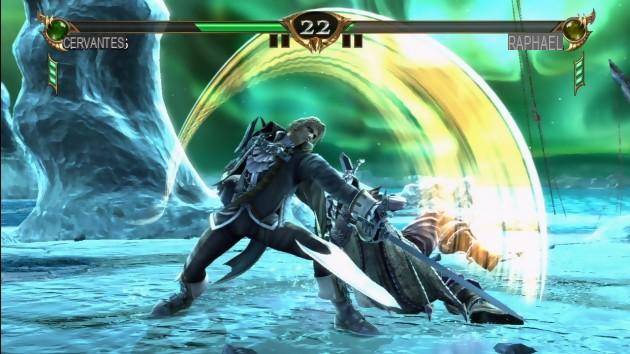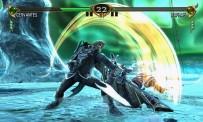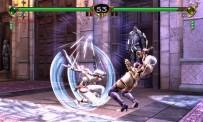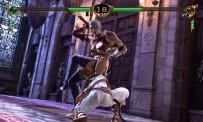 Even if Soul Calibur IV wants to be the equal of its predecessors, and takes up some of the ingredients on which the dynasty built its reputation, the game represents a fracture on Xbox 360 and PlayStation 3, as if Bandai Namco Games wanted to create a new trilogy in high-definition, and make a clean sweep of the past. Usually deep when it comes to depicting the destiny of each of the warriors, the biographies of the characters are rather in the light although the syllables may still seem numerous. Present since the creation of the series, Cervantes was ejected from the trio of main characters he formed with Siegried and Nightmare, Zasalamel having taken his place to continue to feed the evil alter ego of the ex-leader of the Schwarzwind. In Soul Calibur IV, it's always about getting your hands on the Soul Edge, the eternal absolute weapon with a devilish and angelic face at the same time, which consumes souls when handled upside down. Soul Calibur III ended with the inevitable clash between Siegfried and Nightmare, a fight that reduced them to ashes. Finally, Siegfried will owe his resurrection to the Soul Calibur which will leave him as a legacy the huge scar that now pierces his face. As for Nightmare, he will take shape again in the Castle of Ostrheinsburg, with the firm intention of reuniting all the fragments of the Soul Edge; these two are called to meet again. While it was expected that the other characters in the cast of Soul Calibur IV would have a real credible connection to Soul Edge, the scriptwriters at Bandai Namco Games once again settled for relying on a pair - Siegfried and Nightmare - certainly symbolic, but which does not allow to break this linearity which has characterized the franchise since the dawn of time. Where the developers promised us resumes worthy of the name, we find ourselves once again with side stories without much interest. The deal signed with the Star Wars license does not change the situation, and on the contrary accentuates the soporific effect of the solo modes of Soul Calibur IV.
Even if Soul Calibur IV wants to be the equal of its predecessors, and takes up some of the ingredients on which the dynasty built its reputation, the game represents a fracture on Xbox 360 and PlayStation 3, as if Bandai Namco Games wanted to create a new trilogy in high-definition, and make a clean sweep of the past. Usually deep when it comes to depicting the destiny of each of the warriors, the biographies of the characters are rather in the light although the syllables may still seem numerous. Present since the creation of the series, Cervantes was ejected from the trio of main characters he formed with Siegried and Nightmare, Zasalamel having taken his place to continue to feed the evil alter ego of the ex-leader of the Schwarzwind. In Soul Calibur IV, it's always about getting your hands on the Soul Edge, the eternal absolute weapon with a devilish and angelic face at the same time, which consumes souls when handled upside down. Soul Calibur III ended with the inevitable clash between Siegfried and Nightmare, a fight that reduced them to ashes. Finally, Siegfried will owe his resurrection to the Soul Calibur which will leave him as a legacy the huge scar that now pierces his face. As for Nightmare, he will take shape again in the Castle of Ostrheinsburg, with the firm intention of reuniting all the fragments of the Soul Edge; these two are called to meet again. While it was expected that the other characters in the cast of Soul Calibur IV would have a real credible connection to Soul Edge, the scriptwriters at Bandai Namco Games once again settled for relying on a pair - Siegfried and Nightmare - certainly symbolic, but which does not allow to break this linearity which has characterized the franchise since the dawn of time. Where the developers promised us resumes worthy of the name, we find ourselves once again with side stories without much interest. The deal signed with the Star Wars license does not change the situation, and on the contrary accentuates the soporific effect of the solo modes of Soul Calibur IV.
L'histoire sans fin
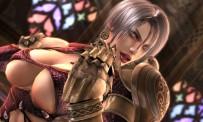 While Soul Calibur III sported a "Legends of Souls" mode for the refreshing month, and which had the merit of actively involving the player in the quest for characters by multiplying the paths, Soul Calibur IV displays a "Story" mode at a discount, let's not be afraid of words. Five stages - or chapters, it depends - in all and for all to cross, with at the end the feeling of having been taken for a moron. The observation may seem severe, it's true, but fighting several opponents in a single round as if it were a "Survival" is rather light. That said, the "Story" mode imposes a minimum of challenge, especially on difficult, with an AI capable of pulling out combos as vicious as those of DTN. At the end of each fight, the player is rewarded with a certain number of points depending on the performance - remaining PV bonus, remaining time bonus, KO bonus, equipment destruction bonus, ring exit bonus... - achieved in the field . These same points are then converted into ecus to allow the purchase of new clothes, as well as new weapons at the grocery store on the corner. Finally, the "Story" mode is also an opportunity to unlock arenas from old opuses brought up to date, as well as additional fighters like Shura and Ashlotte; warriors for whom no parts will be requested, unlike the basic characters each sold for 4000 gold. Unlocking a character is therefore not an insurmountable ordeal in Soul Calibur IV, Bandai Namco Games having preferred to introduce a purchasing system that avoids having to resort to the famous time release, and pushes neophytes to place moves that allow them to earn as many points as possible. The solo Soul Calibur IV also includes an "Arcade" mode, archi-classic this one, in which it will be necessary to cross seven levels to hope to face the infamous Algol.
While Soul Calibur III sported a "Legends of Souls" mode for the refreshing month, and which had the merit of actively involving the player in the quest for characters by multiplying the paths, Soul Calibur IV displays a "Story" mode at a discount, let's not be afraid of words. Five stages - or chapters, it depends - in all and for all to cross, with at the end the feeling of having been taken for a moron. The observation may seem severe, it's true, but fighting several opponents in a single round as if it were a "Survival" is rather light. That said, the "Story" mode imposes a minimum of challenge, especially on difficult, with an AI capable of pulling out combos as vicious as those of DTN. At the end of each fight, the player is rewarded with a certain number of points depending on the performance - remaining PV bonus, remaining time bonus, KO bonus, equipment destruction bonus, ring exit bonus... - achieved in the field . These same points are then converted into ecus to allow the purchase of new clothes, as well as new weapons at the grocery store on the corner. Finally, the "Story" mode is also an opportunity to unlock arenas from old opuses brought up to date, as well as additional fighters like Shura and Ashlotte; warriors for whom no parts will be requested, unlike the basic characters each sold for 4000 gold. Unlocking a character is therefore not an insurmountable ordeal in Soul Calibur IV, Bandai Namco Games having preferred to introduce a purchasing system that avoids having to resort to the famous time release, and pushes neophytes to place moves that allow them to earn as many points as possible. The solo Soul Calibur IV also includes an "Arcade" mode, archi-classic this one, in which it will be necessary to cross seven levels to hope to face the infamous Algol.
Inspired by 2D fighting, Soul Calibur IV introduces tag team combat, but in a much less effective way. [...] In short, an art poorly mastered by the developers."
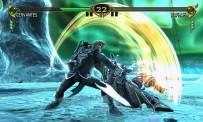 Here again, very specific criteria - level achieved, health bonus, soul gauge bonus, time bonus, consecutive win bonus, perfect... - define the number of points and coins awarded. The third axis of Soul Calibur IV's solo concerns the "Tower of Lost Souls" mode. Here, it will be a question of climbing one by one the sixty floors of the tower with, for each of them, a boss to defeat. If on paper the task to be accomplished is reminiscent of that of Billy Lo (alias Bruce Lee) in the film "The Game of Death", the rules are quite different once in the pagoda. Indeed, several guards - usually easy to defeat - escort their boss with the sole purpose of munching the player's life bar before the fight of the masters. If it will therefore be necessary to take care to place the attacks well to keep intact its chances of victories, one will also have to pay particular attention to the skills of the thugs, as well as those of his own character. They condition both the blows inflicted on the opponent and the damage suffered. Anti-exit A, for example, grants a high probability of avoiding a ring exit. Damage Soul Gauge B, meanwhile, grants increased damage to the opponent's Soul Gauge when an attack is parried. We could also cite Auto Counterattack. C - low probability of transforming the next attack hitting the opponent into a counter-attack -, Impact healing - in the event of a successful guard impact, HP recovery proportional to the strength of the guard impact -, or even Auto anti-grab. A - high probability of avoiding a hold in the event of a throw - which are all skills capable of reversing the course of a fight, whether automatic or manual. Let purists be reassured, these abilities are only taken into account in the “Versus Special”, “Story” and “Tower of Lost Souls” modes, since it is necessary to maintain a minimum of seriousness. Each fight in the tower is an opportunity to flush out a thong or an underwear, luxury treasures it seems for budding designers or graphic artists. Inspired by 2D fighting, Soul Calibur IV introduces tag team combat, but in a much less effective way. The possibilities of striker type combos are nil, and the switch between the characters is weak since a gauge limits the number of permutations. In short, an art poorly mastered by the developers.
Here again, very specific criteria - level achieved, health bonus, soul gauge bonus, time bonus, consecutive win bonus, perfect... - define the number of points and coins awarded. The third axis of Soul Calibur IV's solo concerns the "Tower of Lost Souls" mode. Here, it will be a question of climbing one by one the sixty floors of the tower with, for each of them, a boss to defeat. If on paper the task to be accomplished is reminiscent of that of Billy Lo (alias Bruce Lee) in the film "The Game of Death", the rules are quite different once in the pagoda. Indeed, several guards - usually easy to defeat - escort their boss with the sole purpose of munching the player's life bar before the fight of the masters. If it will therefore be necessary to take care to place the attacks well to keep intact its chances of victories, one will also have to pay particular attention to the skills of the thugs, as well as those of his own character. They condition both the blows inflicted on the opponent and the damage suffered. Anti-exit A, for example, grants a high probability of avoiding a ring exit. Damage Soul Gauge B, meanwhile, grants increased damage to the opponent's Soul Gauge when an attack is parried. We could also cite Auto Counterattack. C - low probability of transforming the next attack hitting the opponent into a counter-attack -, Impact healing - in the event of a successful guard impact, HP recovery proportional to the strength of the guard impact -, or even Auto anti-grab. A - high probability of avoiding a hold in the event of a throw - which are all skills capable of reversing the course of a fight, whether automatic or manual. Let purists be reassured, these abilities are only taken into account in the “Versus Special”, “Story” and “Tower of Lost Souls” modes, since it is necessary to maintain a minimum of seriousness. Each fight in the tower is an opportunity to flush out a thong or an underwear, luxury treasures it seems for budding designers or graphic artists. Inspired by 2D fighting, Soul Calibur IV introduces tag team combat, but in a much less effective way. The possibilities of striker type combos are nil, and the switch between the characters is weak since a gauge limits the number of permutations. In short, an art poorly mastered by the developers.
Koko Made Da!
 Like its predecessor, Soul Calibur IV has a "Character Creation" mode that has the mouth, let's face it. The next gen effect has something to do with it no doubt, for many even, and disguising your character in order to then show it off during online matches, or other Gnouz Ranking, is a perfectly assumed coquetry. It's a bias. The dressing room stretches out to infinity, and the costume combinations are multiple. Bandai Namco Games did better therefore, even if the clothes are common to all the characters, unlike Virtua Fighter 5 where the fighters benefit from outfits reserved for them. The creative parameters always remain the same: haircut, face, skin color, tone of voice, gender, eye color... Apart from the possibility of assigning such or such skill, it is above all the fact that warriors can now fight in briefs and flip flops that makes players fantasize. It promises in the rooms. Unlike Soul Calibur III, which allowed itself a few eccentricities, the combat style of the characters created is no longer inspired by a fruit and vegetable merchant or a tecktonik dancer. Chance has given way to rigor, and it will now be necessary to choose among the soul of which take up the attacks of the original characters. These castes are not all available from the start, and it will be necessary to accumulate a few hours of play before having an exhaustive list. This initiative taken by the developers not only offers the possibility of accessing a command list with any warrior designed (which was not the case in Soul Calibur III), and also prevents Bandai Namco Games from taking over shots at Tekken. As always, a few artists can let their imaginations run wild, and it's not impossible to come across a video game or anime hero around the corner.
Like its predecessor, Soul Calibur IV has a "Character Creation" mode that has the mouth, let's face it. The next gen effect has something to do with it no doubt, for many even, and disguising your character in order to then show it off during online matches, or other Gnouz Ranking, is a perfectly assumed coquetry. It's a bias. The dressing room stretches out to infinity, and the costume combinations are multiple. Bandai Namco Games did better therefore, even if the clothes are common to all the characters, unlike Virtua Fighter 5 where the fighters benefit from outfits reserved for them. The creative parameters always remain the same: haircut, face, skin color, tone of voice, gender, eye color... Apart from the possibility of assigning such or such skill, it is above all the fact that warriors can now fight in briefs and flip flops that makes players fantasize. It promises in the rooms. Unlike Soul Calibur III, which allowed itself a few eccentricities, the combat style of the characters created is no longer inspired by a fruit and vegetable merchant or a tecktonik dancer. Chance has given way to rigor, and it will now be necessary to choose among the soul of which take up the attacks of the original characters. These castes are not all available from the start, and it will be necessary to accumulate a few hours of play before having an exhaustive list. This initiative taken by the developers not only offers the possibility of accessing a command list with any warrior designed (which was not the case in Soul Calibur III), and also prevents Bandai Namco Games from taking over shots at Tekken. As always, a few artists can let their imaginations run wild, and it's not impossible to come across a video game or anime hero around the corner.
High-definition obliges, the character design is doped with creatine with fighters who now display a physique as silicone as those of the Dead or Alive series.
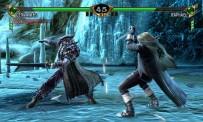 If Soul Calibur III had pushed the PlayStation 2 to its limits, Soul Calibur IV is the first part of the series to enter the next gen era. Bandai Namco Games didn't take half measures, and we won't take any risks in saying that Soul Calibur IV is the most beautiful 3D fighting game today. High-definition obliges, the character design is doped with creatine with fighters who now display a physique as silicone as those of the Dead or Alive series. The animation is still fluid, whether on Xbox 360 or PlayStation 3, and the fighters continue to adopt a victorious pose at the end of each versus. However, there were some slowdowns on the Sailor's Rest level, a finding that affects both machines. As for the costumes, Bandai Namco Games has also made a big effort with 2P outfits that slam, especially those of Cervantes, Taki, Yunsung and Ivy. Time continues to mark the face of the characters, and the most dosed will notice that Astaroth 2P is losing muscle volume. The lighting effects still seduce the retina as much, and the quality of the arenas has not weakened since 2005. Some of them, such as Imperial Garden of Tesmophoros and Distant Marsh, are a true homage to nature. We will also appreciate the Ghost Pavilion and its volcanic hues, or even Ostrheinsburg Castle, the throne room and its riders who take a step forward with each blow. As for the structure of the battlefields, Bandai Namco Games relied on the concept initiated in Soul Calibur II, namely arenas that are not completely closed to promote wall combos, and create ring out situations. Always efficient.
If Soul Calibur III had pushed the PlayStation 2 to its limits, Soul Calibur IV is the first part of the series to enter the next gen era. Bandai Namco Games didn't take half measures, and we won't take any risks in saying that Soul Calibur IV is the most beautiful 3D fighting game today. High-definition obliges, the character design is doped with creatine with fighters who now display a physique as silicone as those of the Dead or Alive series. The animation is still fluid, whether on Xbox 360 or PlayStation 3, and the fighters continue to adopt a victorious pose at the end of each versus. However, there were some slowdowns on the Sailor's Rest level, a finding that affects both machines. As for the costumes, Bandai Namco Games has also made a big effort with 2P outfits that slam, especially those of Cervantes, Taki, Yunsung and Ivy. Time continues to mark the face of the characters, and the most dosed will notice that Astaroth 2P is losing muscle volume. The lighting effects still seduce the retina as much, and the quality of the arenas has not weakened since 2005. Some of them, such as Imperial Garden of Tesmophoros and Distant Marsh, are a true homage to nature. We will also appreciate the Ghost Pavilion and its volcanic hues, or even Ostrheinsburg Castle, the throne room and its riders who take a step forward with each blow. As for the structure of the battlefields, Bandai Namco Games relied on the concept initiated in Soul Calibur II, namely arenas that are not completely closed to promote wall combos, and create ring out situations. Always efficient.
The best defense is attack!
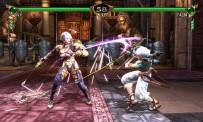 Aficionados know it, Soul Calibur on Dreamcast is considered to be the most successful episode in terms of gameplay. Despite a step described as abused by most purists, the balance of the shots of the first opus has never been questioned; which was not the case for Soul Calibur II, and even less so for Soul Calibur III. Bandai Namco Games was therefore forced to draw the gameplay of Soul Calibur IV from a blank sheet, with the firm intention of favoring the offensive phases. As a result, the advancing and the retreating guard have been removed; the first to prohibit daylight from nibbling frames in the offensive phase with a view to a punishment, the second to reduce attempts to escape from a mind game situation. The reduction in backdash and the impossibility of performing a guard impact on a projection also reflect the offensive philosophy advocated by Bandai Namco Games. Another point: the mugs, which did not track (follow) the opponent in Soul Calibur III can again, which is no longer the case for the classic attacks of the characters. Badly placed, Taki's 6AB,B is badly punished. To come back for two seconds on the guard impact, the developers wanted to make it more noble: a guard impact - in parry or in repel - executed in a vacuum ensures the opponent a counter attack behind. To meditate. For the rest, the regulars will quickly find their marks: it is always a question of combining with the horizontal blows (Square - X), the vertical blows (Triangle - Y), the kicks (Round - B) and the guard (Cross - AT).
Aficionados know it, Soul Calibur on Dreamcast is considered to be the most successful episode in terms of gameplay. Despite a step described as abused by most purists, the balance of the shots of the first opus has never been questioned; which was not the case for Soul Calibur II, and even less so for Soul Calibur III. Bandai Namco Games was therefore forced to draw the gameplay of Soul Calibur IV from a blank sheet, with the firm intention of favoring the offensive phases. As a result, the advancing and the retreating guard have been removed; the first to prohibit daylight from nibbling frames in the offensive phase with a view to a punishment, the second to reduce attempts to escape from a mind game situation. The reduction in backdash and the impossibility of performing a guard impact on a projection also reflect the offensive philosophy advocated by Bandai Namco Games. Another point: the mugs, which did not track (follow) the opponent in Soul Calibur III can again, which is no longer the case for the classic attacks of the characters. Badly placed, Taki's 6AB,B is badly punished. To come back for two seconds on the guard impact, the developers wanted to make it more noble: a guard impact - in parry or in repel - executed in a vacuum ensures the opponent a counter attack behind. To meditate. For the rest, the regulars will quickly find their marks: it is always a question of combining with the horizontal blows (Square - X), the vertical blows (Triangle - Y), the kicks (Round - B) and the guard (Cross - AT).
Contrary to what we initially thought, no sense of timing is required to place a finish move. As soon as the guard is pulverized, all you have to do is stuff the four front buttons for the guillotine to fall."
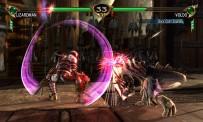 The major innovation brought to the gameplay of Soul Calibur IV is the presence of the soul gauge, which takes up the concept initiated in Soul Blade on PSOne, namely that it is now possible to break the guard. This new rule gives a whole new flavor to the clashes, because the players will no longer be able to content themselves with hiding in a corner of the ring, and contenting themselves with protecting themselves while waiting for the opportune moment to punish the opponent. Indeed, each blow taken by the guard decreases its resistance whose gauge, green at the start, becomes blue to finally turn black. You should know that the characters' armor is now divided into three distinct parts - high, middle, low - and that they can lose them during combat; knowing that it will be necessary to start a new match to find his underpants and his socks. What is practically pleasurable is that a certain logic is respected in the stripping down of the characters. More concretely, if the low protection explodes, it is the lower part of the outfit that disintegrates. The theory applies in the same way for the middle and high sections. When all parts of the outfit are on the ground, the damage taken increases by 10 to 15%, even 20% in some cases. Once the guard is completely broken, the player with the advantage can perform a Critical Finish to end the round - or the match - in one fell swoop by pressing the four front buttons. Contrary to what we initially thought, no sense of timing is required to place a finish move. As soon as the guard is pulverized, all you have to do is press the four buttons on the front - or press a shortcut button for the most lazy - for the guillotine to fall. That said, during high-level fights, few players resort to Critical Finish. Even if their integration does not disturb the course of the fight, it is clear that they are far from sublime. Finally, to finish with the characters from the Star Wars universe, the developers have tried to provide them with attacks that live up to their reputation. Thus, Yoda, without being considered abused, can rely on his small size to avoid the majority of high and even middle attacks. Moreover, it is very difficult to catch, even when it is level with the face of its adversary. However, these Jedi advantages are offset by less punching power. Darth Vader, on the other hand, is much slower, but benefits from much more powerful attacks, which makes him a particularly balanced character. As for the Apprentice, he is capable of unleashing priority blows bordering on the paranormal. Cracked, naturally, even if he tends to eat his Force bar without restraint.
The major innovation brought to the gameplay of Soul Calibur IV is the presence of the soul gauge, which takes up the concept initiated in Soul Blade on PSOne, namely that it is now possible to break the guard. This new rule gives a whole new flavor to the clashes, because the players will no longer be able to content themselves with hiding in a corner of the ring, and contenting themselves with protecting themselves while waiting for the opportune moment to punish the opponent. Indeed, each blow taken by the guard decreases its resistance whose gauge, green at the start, becomes blue to finally turn black. You should know that the characters' armor is now divided into three distinct parts - high, middle, low - and that they can lose them during combat; knowing that it will be necessary to start a new match to find his underpants and his socks. What is practically pleasurable is that a certain logic is respected in the stripping down of the characters. More concretely, if the low protection explodes, it is the lower part of the outfit that disintegrates. The theory applies in the same way for the middle and high sections. When all parts of the outfit are on the ground, the damage taken increases by 10 to 15%, even 20% in some cases. Once the guard is completely broken, the player with the advantage can perform a Critical Finish to end the round - or the match - in one fell swoop by pressing the four front buttons. Contrary to what we initially thought, no sense of timing is required to place a finish move. As soon as the guard is pulverized, all you have to do is press the four buttons on the front - or press a shortcut button for the most lazy - for the guillotine to fall. That said, during high-level fights, few players resort to Critical Finish. Even if their integration does not disturb the course of the fight, it is clear that they are far from sublime. Finally, to finish with the characters from the Star Wars universe, the developers have tried to provide them with attacks that live up to their reputation. Thus, Yoda, without being considered abused, can rely on his small size to avoid the majority of high and even middle attacks. Moreover, it is very difficult to catch, even when it is level with the face of its adversary. However, these Jedi advantages are offset by less punching power. Darth Vader, on the other hand, is much slower, but benefits from much more powerful attacks, which makes him a particularly balanced character. As for the Apprentice, he is capable of unleashing priority blows bordering on the paranormal. Cracked, naturally, even if he tends to eat his Force bar without restraint.
